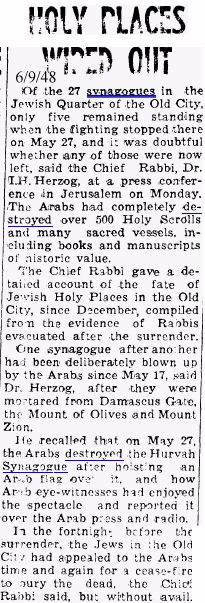One of my favorite places in the world is the Jewish Quarter in the Old City of Jerusalem. The stones are soaked in history and the roads filled with Jews and non-Jews of all kinds seeking to hear what the Old City has to say.
A landmark of the Jewish Quarter was the Churva synagogue ruins. A majestic arch was all that remained of a beautiful synagogue in the Jewish Quarter square. That landmark has now been supplanted by a far more majestic one. The rebuilt synagogue dominates the Cardo / Square area. I was given a tour and some history that I would like to share with you.
The original synagogue on this plot was built in the early 18th century by students of R’ Yehuda HaChassid who settled in Jerusalem. In order to build the synagogue the builders borrowed a hefty sum from the local Ottoman Arabs. When they fell significantly into arrears, the lenders had the synagogue razed.
For over 140 years the synagogue lay in ruin and became known as the Churva, “Destroyed”. In the late 19th century, students of the Vilna Gaon rebuilt the synagogue and it flourished again as the main synagogue for the Jews living in the Old City. It became an international symbol of Jewish pride and the center for Jewish religious life in Jerusalem.
During the 1948 war for Independence, the synagogue was razed once again by Arabs. This time, not for a debt, rather for vengeance. After the war, the Old City remained under Arab control and the synagogue remained a pile of rubble.
In 1967, Israel regained control over the area. The Churva shul was a priority and it was hoped that it would be rebuilt quickly. Ten years later, with no progress to speak of, the city built a commemorative arch to be a placeholder until the synagogue was rebuilt in earnest. This is the familiar arch that most visitors to the Old City will recall over the last 30 years.
Finally, about 5 years ago, construction commenced and was recently completed. The result is a magnificent building which retains many of the same elements as the two original structures. The outside view is beautiful.
Inside, takes it a whole new level. I felt like I was in the most beautiful shul I had ever been to. Once you get inside, the building takes on the familiar mode of many older synagogues with a main sanctuary on the ground level and balconies for women. The bima is in the middle of the sanctuary.
The artwork throughout the building is beautiful. There are paintings above the entrance as you can see above. There is stained glass all around the shul. The stone work and moldings are exquisite. But most of all, I loved the paintings in the ceiling corners.
The ark is stunning as well. It looks like there are two arks but really there is just one. How would they use the top one!? The bottom ark is the functional ark. The Torah scrolls are stored in there. The top section is not an ark at all. It just looks nice.
As you can see, the synagogue is stunning. If you look carefully you can see the wall is made of two shades of stone. I believe, the darker stone is original stone from the ruins and the lighter stone is the new stone.
For me, greater than the physical beauty of the shul is the symbolism of the shul. Its original builders were chasidic mystics risked everything to come to Jerusalem in an attempt to hasten the coming of the Messiah. The next builders were vehement opponents of the chasidic movement. The most recent builders was the government of Israel. Now, the shul is maintained by the Zilberman family of the Old City. Four groups of Jews that may not share all that much in common. But the shul connects them all.
Isn’t that one of the points of a shul? To build community? To connect people who would otherwise be disconnected? From Judaism? Or even just from each other?
I think it is. That is why I am proud to represent the Pacific Jewish Center | The Shul on the Beach. Our shul also connects all sorts of people. Our shul is also a common thread among diverse people. The Churva shul is a model for us and others. I hope more shuls can take this model and implement it in their communities in the hope that we can foster unity among our people.
Taking it one step further, the Churva shul has been destroyed twice. And rebuilt twice as well. Our Temple was destroyed twice but only rebuilt (from scratch) once so far. We hope and pray that the Third Temple will be rebuilt speedily in our days.
Finally, in our lives we too can feel destroyed sometimes. Look to the Churva shul for inspiration and hopefully we can rebuild ourselves as beautifully as the Churva shul has been rebuilt.



